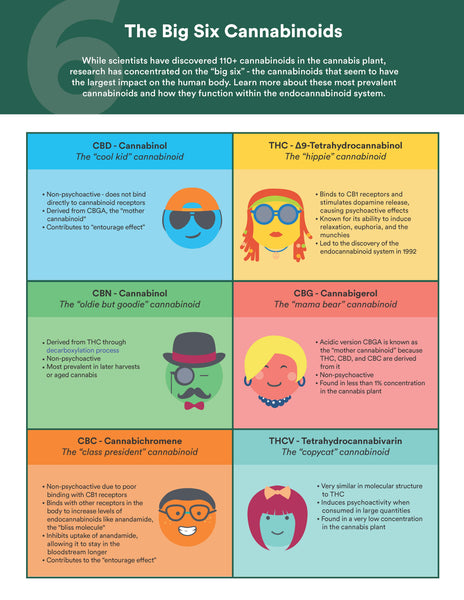There’s More Than CBD: Meet the “Big Six” Phytocannabinoids

When it comes to full-spectrum hemp extracts, it’s not a one-man show. CBD may be a starring ingredient, but it’s actually part of a full-on Broadway ensemble featuring over 110 other cannabinoids.
Cannabinoids are essentially the chemical messengers for the endocannabinoid system. The endocannabinoid system (ECS) is a biological system composed of endocannabinoids and cannabinoid receptors which are distributed throughout the body’s central nervous system and peripheral nervous system.
There are three distinct classes of cannabinoids: endocannabinoids, phytocannabinoids, and synthetic cannabinoids. Endocannabinoids are produced by the body; phytocannabinoids are created in plants; synthetic cannabinoids are manufactured artificially.
Today, we’re going to explore the “big six” phytocannabinoids and why they’ve gained so much attention in scientific research. But first, let’s dive into a quick recap on the differences between endocannabinoids and phytocannabinoids.
Endocannabinoids vs. Phytocannabinoids
To understand the formation and function of endocannabinoids, it’s important to first understand how the brain cells communicate with each other and the rest of the body. Brain cells, or neurons, send messages to the rest of the body through neurotransmitters. These neurotransmitters can pass along a variety of messages that tell various parts of the body how to function. There are two types of cells: presynaptic and postsynaptic. Neurotransmitters are usually released by a neuron in the presynaptic cell to travel across the synapse, a small gap between cells. They then attach to receptors on the postsynaptic cell. This activates the neurons in the postsynaptic cell and allows the message to be passed along.
Endocannabinoids work the opposite way. When the postsynaptic neuron is activated, endocannabinoids are made “on-demand” from fat cells already present in the neuron. Then they are released from that cell and travel backward to the presynaptic neuron, where they attach to cannabinoid receptors. This then changes the way the presynaptic cell responds to other messages.
Thus far, five types of endocannabinoids have been discovered with the two most well-known and studied being anandamide (named after the Sanskrit word for “bliss”) and 2AG.
Phytocannabinoids, or plant-derived cannabinoids, are formed a bit differently than endocannabinoids but operate in a very similar fashion. Phytocannabinoid production starts when an enzyme causes geranyl pyrophosphate and olivetolic acid to combine and form cannabigerolic acid (CBGA). CBGA then converts into cannabigerol (CBG) via a process called decarboxylation, which happens as a cannabinoid is exposed to light or heat. CBG is known as the “mother cannabinoid” because it serves as the original form of many other cannabinoids, including THC, CBD, and CBC. Specific enzymes break CBG down and determine which direction it will go. Higher yields of CBG in the cannabis plant obviously result in higher yields of desirable cannabinoids like THC and CBD, so breeders are now experimenting with genetic manipulation through the cross-breeding of plants.
Related Article: What Are Cannabinoids and What Do They Do?
The “Big Six” Cannabinoids
A majority of scientific research has focused on six phytocannabinoids in particular: CBD, THC, CBN, CBG, CBC, and THCV. These cannabinoids have earned the spotlight in research due to either their abundance in the cannabis plant or their sizable role in the impact of cannabis on the body. If you’re reading this blog, you’re probably already familiar with CBD and THC as they’ve become the most well-known due to their naturally high levels in recreational cannabis and hemp. However, the other four on this list may not have crossed your radar yet. Let’s take a look!
P.S. You can meet these cannabinoids firsthand by adding a full-spectrum hemp extract to your daily supplement routine. Shop Bluebird's best-selling hemp extract products to get to know the "big six" in person!











